

Hattie's Index Of Teaching & Learning Strategies: 39 Effect Sizes In Ascending Order. An Index Of Teaching & Learning Strategies: 39 Effect Sizes In Ascending Order by Dana Schon, sai-iowa.org Effect Size Defined Statistically speaking, the strength of the relationship between two variables.
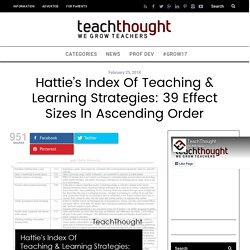
John Hattie, Professor of Education and Director of the Melbourne Education Research Institute at the University of Melbourne, Australia, says ‘effect sizes’ are the best way of answering the question ‘what has the greatest influence on student learning?’ Effect Size Applied. Goal setting poster for students & educators: 54 Flipped Classroom Tools For Teachers And Students -
54 Flipped Classroom Tools For Teachers And Students by TeachThought Staff. Education Week. By Dr.
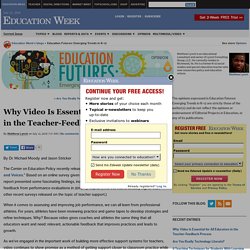
Michael Moody and Jason Stricker The Center on Education Policy recently released a report called "Listen to Us: Teacher Views and Voices. " Based on an online survey given last winter to educators around the country, the report presented some fascinating findings, including that only about half of educators found the feedback from performance evaluations in 2014-15 helpful. (And this stat is actually higher than other recent surveys released on the topic of teacher support.) When it comes to assessing and improving job performance, we can all learn from professional athletes. 26 Sentence Stems For Higher-Level Discussion In The Classroom. 26 Sentence Stems For Higher-Level Conversation In The Classroom by Terry Heick Meaningful conversation can make learning more personal, immediate, and emotional.
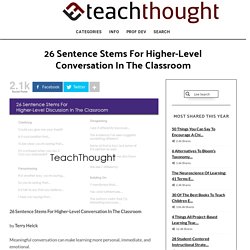
During meaningful conversations, students are forced to be accountable for their positions, to listen, to analyze opposing perspectives, and to adapt their thinking on the fly. Education Week. We all teach, lead and learn under different Mindframes.
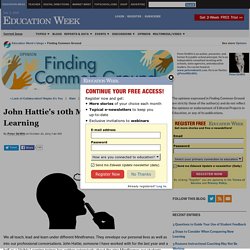
They envelope our personal lives as well as into our professional conversations. Assessment Design: A Matrix To Assess Your Assessments. Assessment Design: A Matrix To Assess Your Assessments by Grant Wiggins, Authentic Education On Rigor, Language, & Verbs Rigor is not established by the unthinking use of Webb or Bloom or other verbs.
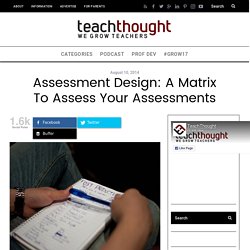
Here, for example, is a widely-findable chart I found on the NJ Dept of Education website, in which Webb’s rubrics have been turned into a leveled chart of supposedly-appropriate verbs: Assessment Design: A Matrix To Assess Your Assessments. Kids Speak Out on Student Engagement. A while back, I was asked, "What engages students? " Sure, I could respond, sharing anecdotes about what I believed to be engaging, but I thought it would be so much better to lob that question to my own eighth graders.
The responses I received from all 220 of them seemed to fall under 10 categories, representing reoccuring themes that appeared again and again. So, from the mouths of babes, here are my students' answers to the question: "What engages students? " 1. How do you use the last five minutes? How do you ensure every student has left the classroom feeling they have learned and accomplished something, no matter how small?
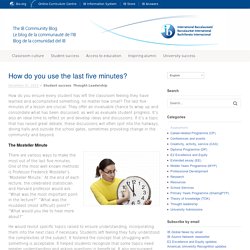
The last five minutes of a lesson are crucial. They offer an invaluable chance to wrap up and consolidate what has been discussed, as well as evaluate student progress. It’s also an ideal time to reflect on and develop ideas and discussions. If it’s a topic that has raised great debate, these discussions will often spill into the hallways, dining halls and outside the school gates, sometimes provoking change in the community and beyond. The Mosteller Minute There are various ways to make the most out of the last five minutes. He would revisit specific topics raised to ensure understanding, incorporating them into the next class if necessary. Some teachers use a ‘Parking Lot’ system: a list of student ideas or questions written on a flipchart or whiteboard for further explanation at the end of a lesson.
Visible thinking techniques Homework preparation. IB Physics: Start with the misconception. Saturday 23 January 2016 View all posts It's a big problem that students often remember what they have learnt before rather than what we try to teach them.
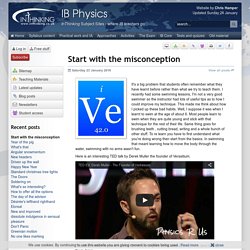
I recently had some swimming lessons, I'm not a very good swimmer so the instructor had lots of useful tips as to how I could improve my technique. This made me think about how I picked up these bad habits. Well, I suppose it was when I learnt to swim at the age of about 6. 8 practices teachers can put in place to develop visible learners. Find out more at. Know Thy Impact Visible Learning in Theory and Practice. Is there one great phrase to boost student effort and performance? - Assessment Literacy. Have you read Daniel Coyle’s book, The Talent Code?
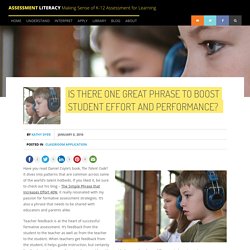
It dives into patterns that are common across some of the world’s talent hotbeds. If you liked it, be sure to check out his blog – The Simple Phrase that Increases Effort 40%; it really resonated with my passion for formative assessment strategies. It’s also a phrase that needs to be shared with educators and parents alike. Teacher feedback is at the heart of successful formative assessment. It’s feedback from the student to the teacher as well as from the teacher to the student.
In his blog, Daniel shared research by a team of psychologists from various universities that was designed to determine if there was a best practice for providing constructive feedback. How To Give Students Specific Feedback That Actually Helps Them Learn. How To Give Students Specific Feedback That Actually Helps Them Learn by Justin Chando To tell a student “great job”or “this needs work” is a missed opportunity.

Everyone loves to hear they did a great job. And perhaps your student really did nail this latest assignment. 7 Key Characteristics Of Better Learning Feedback. 7 Key Characteristics Of Better Learning Feedback by Grant Wiggins, Authentic Education On May 26, 2015, Grant Wiggins passed away.
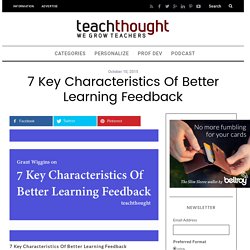
Grant was tremendously influential on TeachThought’s approach to education, and we were lucky enough for him to contribute his content to our site. Occasionally, we are going to go back and re-share his most memorable posts. Yesterday we shared an article on close reading, and today Grant looks at providing better feedback for learning. Hattie's Index Of Teaching & Learning Strategies: 39 Effect Sizes In Ascending Order. An Index Of Teaching & Learning Strategies: 39 Effect Sizes In Ascending Order by Dana Schon, sai-iowa.org Effect Size Defined Statistically speaking, the strength of the relationship between two variables.
John Hattie, Professor of Education and Director of the Melbourne Education Research Institute at the University of Melbourne, Australia, says ‘effect sizes’ are the best way of answering the question ‘what has the greatest influence on student learning?’ Effect Size Applied Reverse effects are self-explanatory, and below 0.0Developmental effects are 0.0 to 0.15, and the improvement a child may be expected to show in a year simply through growing up, without any schooling. Effect Size CAUTION. Feedback for Learning Infographic - VISIBLE LEARNING. “Most of the feedback that students receive about their classroom work is from other students – an much of that feedback is wrong.” (John Hattie) The Association for Supervision and Curriculum Development (ASCD) is an international non-profit organization for teachers and educators. Its mission is “to develop programs, products, and services essential to the way educators learn, teach, and lead.” The Educational Leadership Magazine is ASCD’s flagship publication that is sent to its members eight times a year; subscriptions and individual issues are also available.